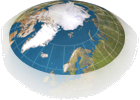 |
The Terrestial
Ecosystem Or Ecosystems
Terriestial ecosystem: The overall message |
| |
Terrestrial ecosystems have changed
in the past, are changing now, and will change in the future. |
| |
The systems respond to climate variations
in space and time, ranging from the small scale tundra polygons
to circumpolar movements of vegetation and animals. |
| |
Plants, animals and micro-organism
are intimately linked locally, both above and below ground, and
across landscapes. |
| |
Heat (energy), water, carbon and nutrients
are transferred into, within and out of the systems by biological
and physical processes. |
| |
Changes in the atmosphere affect the
land, but changes in the land have 'feedback' effects on the atmosphere.
|
| |
You may recognise different types of vegetation (scientists spend
lots of time arguing about classification) and think that they
are the Terrestrial Ecosystems. They certainly have distinct characteristics
and have many internal links. In that sense they are 'ecosystems'.
But it is equally certain that they are dynamic; they are changing;
and they are intimately linked to each other and dynamically linked
to the wider physical environment. Understanding these wider links
is critical when considering protection of species and habitats,
and the use and management of resources. Changes in one place
affect other places. And that applies to changes in the North
affecting the South, and vice versa. One System!
|
